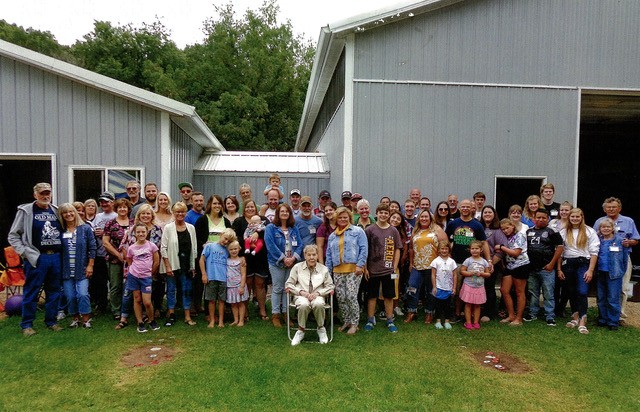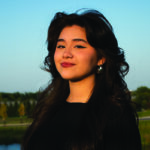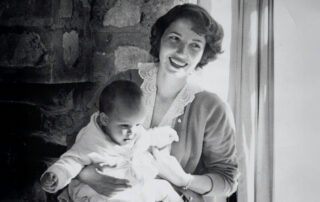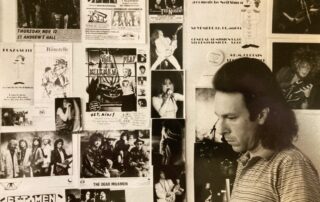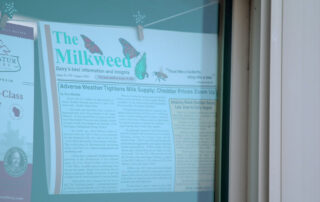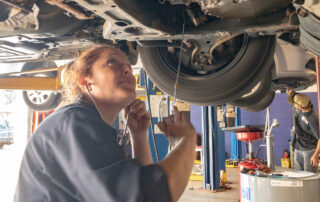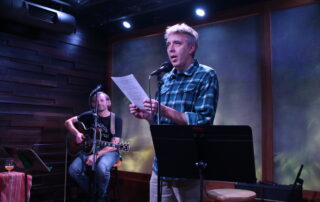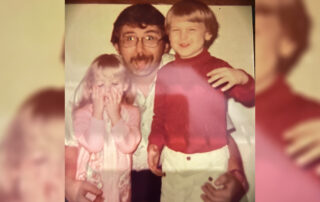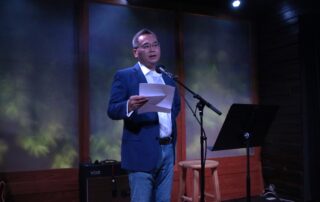Writer McKenna Scherer is a proud Wisconsinite. Sure, that love is tied to cheese and Spotted Cow. But at the root of that love is her family.
Scherer shared a story, “The largest gathering of Norwegians in Northwestern Wisconsin, probably: Gierefest,” at a live storytelling event hosted by Wisconsin Public Radio’s “Wisconsin Life” and the Chippewa Valley Writers Guild. It was held on Nov. 14, 2024 in Eau Claire at The Lakely.
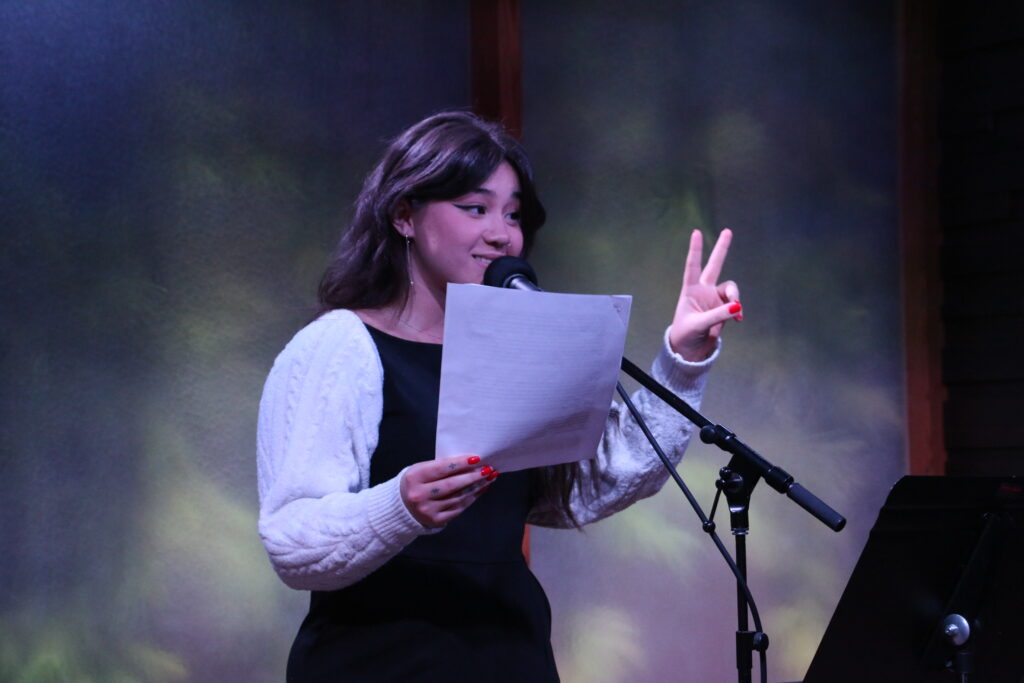
Writer McKenna Scherer, of Eau Claire, shares the story, “The largest gathering of Norwegians in Northwestern Wisconsin, probably: Gierefest,” on stage on Nov. 14, 2024 at The Lakely in Eau Claire. The storytelling event was hosted by WPR’s “Wisconsin Life” and the Chippewa Valley Writers Guild. Rich Kremer/WPR
Wisconsin is perhaps best known as America’s Dairyland. Both of my parents grew up on farms. It’s also known for our love of cheese and beer: I’m partial to a Spotted Cow, myself. Then there’s Harley-Davidson, the Green Bay Packers, the Great Lakes, Friday fish fries and old fashioneds, and the classic “Midwest goodbye,” saying farewell about 32 times before actually leaving.
I identify with a lot of that. But we all come from somewhere, and my family did not always live in America’s Dairyland.
•••
About 150 years ago, a couple of Norwegians — Severt Giere and Ingeborg Larsdatter Male — emigrated from Norway to the United States, landing in the Midwest. They lived over in Minnesota for several years, and by 1920 had settled with their family in Dunn County. That’s about a half-hour drive from where we are tonight.
Severt and Ingeborg had four sons and two daughters. From then on, you can imagine how it went: Those kids got married and had kids of their own, and the cycle repeated, eventually getting to my dad. He met a gal with a big laugh and a bigger heart, my mom, and in 2000, yours truly popped out. There are dozens of us from the Giere side, just from two people willing to risk it all in hopes of a better future for their family. Here, in the Midwest.
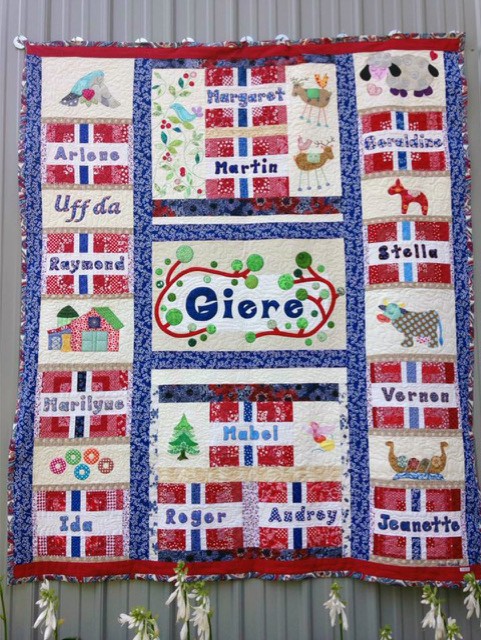
A family member brought this handmade quilt to a Gierefest and it displays a family tree. Photo courtesy of McKenna Scherer
•••
Well, I’m pleased to report that 150 years later, the Gieres are now — and maybe always have been — a bunch of loudmouth Norwegians. I think they taught me my first curse word, and my family knows how much I love those. A room is never quiet when they’re together: cackling women who showed me I never needed to be silent or make myself small. The quieter Giere men have always worked with their hands and loved their family.
A room can get pretty stuffy when it’s filled with a family as big as ours, so the Gieres started having family get-togethers outdoors. One of those first planned family reunions was held over in Dunn County in the ‘90s, and they called it Gierefest.
My Great Aunt Jayette told me something like 11 people were at that reunion, some of whom weren’t even on speaking terms — being a loudmouth can get you in trouble sometimes — and Gierefest was a way to literally bring the family back together.
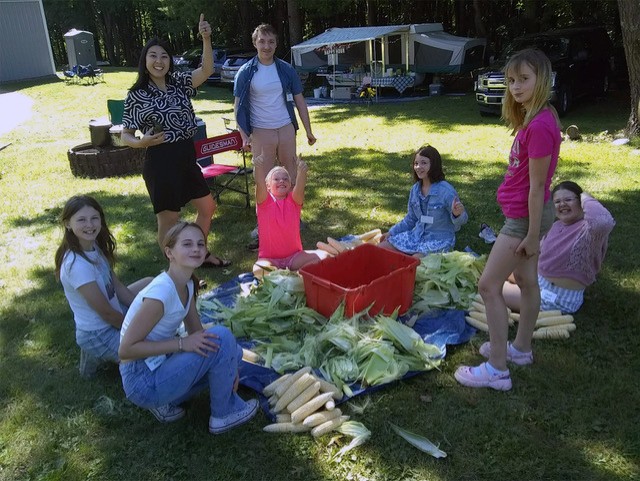
Some of the kids shucking corn as a game because “the rest of us are tired,” said McKenna Scherer. Photo courtesy of McKenna Scherer
For the past near-20 years, my Great Aunt Jayette and Great Uncle Larry Giere have been hosting that family reunion at their Dunn County homestead. Annually, they welcome 70-plus family members for Labor Day weekend when Gierefest is held.
•••
In my 24 years, I don’t remember ever missing one year of Gierefest. Through rain, humidity, good times and less than good times, Gieres show up. I think that kind of commitment to Gierefest is because of three things: two Midwestern, potluck-style meals in one day; the Hestesko Tournament; and because Great Aunt Jayette says so.
I’m sure most of you are curious: What’s Hestesko? “Hestesko” translates from Norwegian to English as “Horseshoes,” the game.
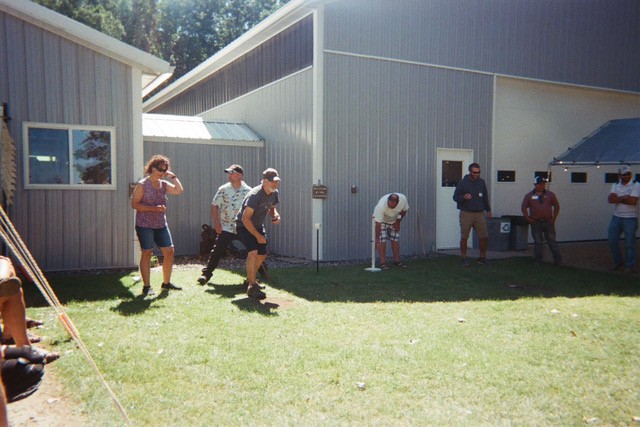
Taken with a disposable camera, 2024 mid-Hestesko tournament at Gierefest in Dunn County. Photo courtesy of McKenna Scherer
If you’ve never played Horseshoes, here are the general rules:
- Traditionally, people play horseshoes with … horseshoes. Gieres don’t do that. We use washers.
- Typically, there’s a nice, groomed pitch to play on. We play on a stretch of grass.
- In horseshoes, you aim at stakes. We just try to get the washer into a hole in the ground.
- It takes two teams of two to play a game, and a coin toss decides which team starts. It’s not that serious for us, so anyone can start.
- Throws must be underhanded. Gieres aren’t very coordinated, so that’s for the best.
- If no “ringers” are made, the nearest horseshoe to the stake gains a point. True, except we’re using washers, and instead of stakes there are just holes in the ground. If it’s too close to call, refs will take a yard stick out and measure down to the centimeter.
No, I’ve never won. My dad has though, twice, so it’s in my blood.
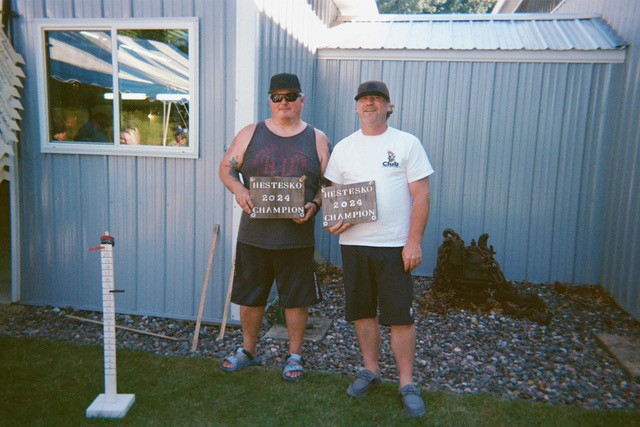
The 2024 winners Hestesko winners with their handmade plaques at Gierefest: McKenna Scherer’s second cousin-in-law Jeremy Lee (l) and her “old man” Justin Scherer (r). Photo courtesy of McKenna Scherer
•••
Nowadays, my favorite part of the reunion is the silent auction. Every family aims to bring at least one thing for it, and the money raised goes right back to the Giere fund. It’s an unspoken rule that every single item will be bought by the end of the auction, no matter what. After all, it’s for family.
Those funds cover the cost of hosting Gierefest, but it’s also a family find. Great Aunt Jayette texted me in early October as we were talking about Gierefest and said, “Did you know that Gierefest actually goes all year long? We take care of family. We’ve donated to family members with MS, cancer; we’ve given money to members to go on mission trips, etc.” Great Uncle Larry added, “Don’t forget about the headstones.”
Headstones?
Glad you asked. The whole reason Gierefest even exists is because of those Norwegians who immigrated to America 150 years ago and settled in the Midwest. But for a long time, the family didn’t even know who was all part of the family tree, or who Severt and Ingabore really were. Great Aunt Jayette came across a headstone one day while visiting a Dunn County cemetery, and all it contained was three words: “Mother. Father. Giere.” When she asked Great Uncle Larry who was laid to rest there, he said, “I dunno.”
Men.
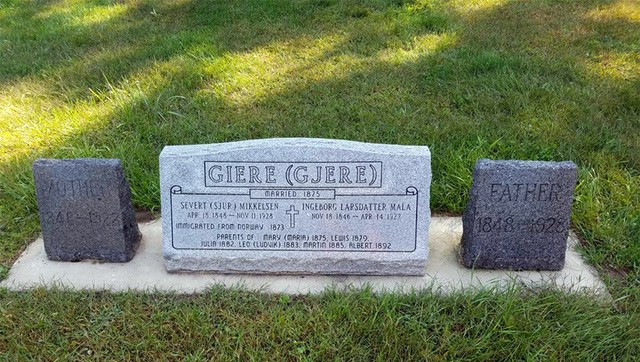
The Giere’s “Mother” and “Father” headstones alongside the new headstone that the family was able to make thanks to funds from Gierefest. Photo courtesy of McKenna Scherer
So, for the past couple of decades, Great Aunt Jayette has made it her mission to not only identify the names of our Giere ancestors but also to get to know them. Putting a name and a face to as many as possible. She has so many stories of poring over the archives of publications that no longer exist; through marriage certificates, property records and census documents; and even stumbling across vintage wares at thrift sales that had the name “Giere” written on them.
Frankly, I haven’t appreciated all of that work and all of that history, until recently. But I should have.
I don’t know who I would be if I didn’t grow up in Wisconsin. I don’t know who I am without the Gieres. I don’t think I’d be a loudmouth, cursing, hardworking woman if I didn’t spend every Labor Day weekend at Gierefest. But I do know one thing: For the Gieres, ‘Uff da’ means family.
==
After Scherer shared her story live on stage at The Lakely, event cohost Maureen McCollum talked with her about the essay.
This interview has been edited for brevity and clarity.

“Wisconsin Life” host Maureen McCollum, left, talks with writer McKenna Scherer after she read her essay “The largest gathering of Norwegians in Northwestern Wisconsin, probably: Gierefest.” Scherer shares her story on stage at The Lakely on Nov. 14, 2024. McCollum co-hosted the event put on by WPR’s “Wisconsin Life” and the Chippewa Valley Writers Guild. Rich Kremer/WPR
Maureen McCollum: Thank you so much for sharing the story, McKenna. Two questions. One, how do I get an invite to Gierefest?
McKenna Scherer: Oh, girl, there are lots of men that I will not introduce you to.
MM: (Laughing) I won’t tell my husband. And second, why did you decide to share this amazing story about your amazing family?
MS: So, when [event co-host] B.J. Hollars and you graciously reached out [about this event], the Gieres were one of the first things, the first people I thought of about my Wisconsin life.
My mom was born in South Korea and was adopted by a family here and grew up on a farm. My dad has very long family roots. I have always felt super, super at home with them. So much so that my boss — who actually grew up around the same area — when he hears me talk, he’s like, “God, you are from there. You sound like you’re from there,” which is maybe not a good thing? I don’t know.
But it really informed me as a person, because [the Gieres] never wanted me to be any different than who I was. And importantly, they never ever asked me to any different than what I was. To kind of echo what Jan [Larson] said, I’m so lucky to have grown up around really strong, really funny women. And I couldn’t have asked for it to be any different.
To hear all the Chippewa Valley writers’ stories from the live storytelling event, check out the full collection at “Wisconsin Life” Live from the Chippewa Valley.
